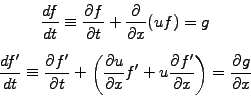

 ','..','$myPermit') ?>
SYLLABUS Previous: 6.1 Splitting advection from
Up: 6 LAGRANGIAN METHOD
Next: 6.3 Non-Linear equations with
','..','$myPermit') ?>
SYLLABUS Previous: 6.1 Splitting advection from
Up: 6 LAGRANGIAN METHOD
Next: 6.3 Non-Linear equations with
Introduced a decade ago by Yabe and Aoki [34], a whole family of schemes have been proposed along the same lines, relying on different interpolations to propagate the solution along the characteristics.
Using a cubic-Hermite polynomial, the discretized function and its first
derivative
![]() is approximated in a continuous
manner with
is approximated in a continuous
manner with
 |
 |
(1) |
![$\displaystyle \left\{ \begin{array}{l} \displaystyle\frac{df}{dt}= 0\\ [5mm] \d...
...rtial g}{\partial x} -\frac{\partial u}{\partial x}f^\prime \end{array} \right.$](s6img17.gif) |
(2) |
For pedagogical reasons, the scheme implemented in JBONE
assumes that
![]() so that both quantities
so that both quantities
![]() can be interpolated from only one piece of the piecewise continuous
polynomial, namely
can be interpolated from only one piece of the piecewise continuous
polynomial, namely ![]() defined in the interval
defined in the interval
![]() .
After an initialization where the
function is discretized
with cubic-Hermite polynomials by sampling on a grid and the
derivative are calculated
with centered finite differences, the CIP scheme is
implemented as
.
After an initialization where the
function is discretized
with cubic-Hermite polynomials by sampling on a grid and the
derivative are calculated
with centered finite differences, the CIP scheme is
implemented as
double alpha=timeStep*diffusCo/(dx[0]*dx[0]); //These are only constant
double beta =timeStep*velocity/(dx[0]); // if the problem and the
int n=f.length-1; // mesh are homogeneous
for (int j=0; j<n; j++) {
a=dx[0]*(df[j]+ df[j+1])-2*(f[j+1]-f[j]);
b=dx[0]*(df[j]+2*df[j+1])-3*(f[j+1]-f[j]);
fp[j+1]= f[j+1] -beta*(dx[0]*df[j+1]-beta*(b-beta*a));
dfp[j+1]= df[j+1] -beta/dx[0]*(2*b-3*beta*a);
}
a=dx[0]*(df[n]+ df[0])-2*(f[0]-f[n]);
b=dx[0]*(df[n]+2*df[0])-3*(f[0]-f[n]);
fp[0]= f[0] -beta*(dx[0]*df[0]-beta*(b-beta*a));
dfp[0]= df[0] -beta/dx[0]*(2*b-3*beta*a);
The applet below illustrates the high quality of this approach, which combines a low level of dispersion with low damping.
Some additional bookkeeping is of course necessary in a code that is intended
for ![]() : exercise 6.01 deals with exactly this problem and can be
implemented in a similar manner as illustrated with the
Cubic--Spline scheme.
: exercise 6.01 deals with exactly this problem and can be
implemented in a similar manner as illustrated with the
Cubic--Spline scheme.
SYLLABUS Previous: 6.1 Splitting advection from Up: 6 LAGRANGIAN METHOD Next: 6.3 Non-Linear equations with